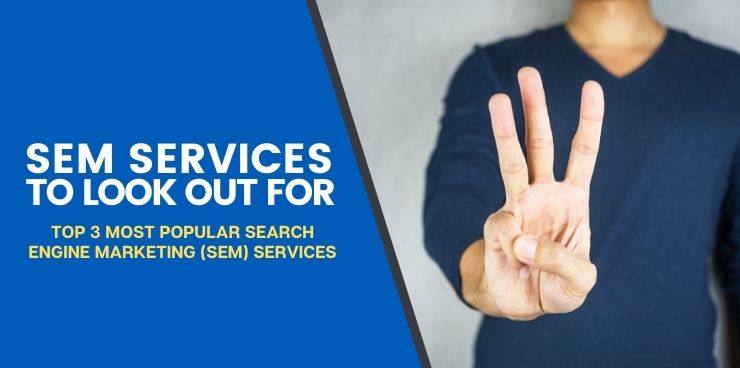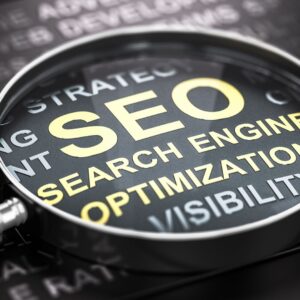Search engines are among the most important pieces of online infrastructure in existence. They’re tools that let anyone with internet access discover almost anything they want to know. A few keystrokes or taps on a touchscreen are all it takes.
That description makes search engines sound as if they’re a public good. They might do good, but they’re also turning an impressive profit. Google alone generated 181.69 billion dollars in revenue in 2020. Most of that money came from advertising.
With such a large and accessible audience, it’s no wonder that search engine marketing services are in high demand. Keep reading to learn everything you need to know about search engine marketing and three of the most popular services.
What is Search Engine Marketing (SEM)?
Search engine marketing or SEM is often confused with search engine optimization. However, it’s a different process with unique applications.
When you practice search engine marketing, it’s paying for an advertisement to appear on a search engine results page. To illustrate this, perform a search for the phrase “SEM agency.”
At the top of the results page, you’ll see one or more ads relevant to that phrase. The companies in those ads paid for them to be displayed there.
Don’t close that tab quite yet—you’ll need it again in a moment.
 What is Search Engine Optimization (SEO)?
What is Search Engine Optimization (SEO)?
You’re probably more familiar with SEO than you are with SEM. It has become a more mainstream marketing activity in recent years.
When the company you’re part of practices SEO, they’re aiming to appear higher in the search results organically. Go back to the page of search results you have open for the phrase “SEM agency.”
Beneath the advertisements are the organic results. The ones you’re looking at are all well-optimized enough compared to their competitors to appear on the first page. That’s where everyone aims to be.
Efforts to optimize a website might include:
- Using keywords.
- Building backlinks.
- High-quality content creation.
- Adding metadata.
- Improving mobile-friendliness.
In some cases, you’ll see SEO under the umbrella of SEM services. Other times, you will see it defined as something completely separate.
What is the Difference? SEM vs. SEO:
The primary difference between SEM and SEO is how your company goes about boosting its ranking on the results page. With SEM, you pay, and with SEO, you don’t.
With SEM, you:
- See your link designated as an ad on the results page.
- Spend money, usually every time a user clicks on your link.
- Are able to target a specific audience easily.
- See immediate results.
With SEO, you:
- Don’t appear as an advertisement on the results page.
- Only pay if you use a marketing agency or other service to optimize your website.
- Are seen by anyone on the results page, although their search phrases may influence the likelihood that they will.
- Need to invest some time into SEO efforts before you see results.
Both SEM and SEO have merit as marketing strategies, and almost every marketing firm will practice both. They’re complementary practices, so doing so is part of a well-rounded marketing strategy.
 How Does SEM Work?
How Does SEM Work?
The algorithms that govern search engine functions are complicated. They’re constantly in flux and occasionally proprietary. The aim of the algorithms, however, is understandable. The designers of search engine algorithms want to provide the most relevant results possible to searchers.
SEM is beneficial for consumers. It means they’re viewing relevant and actionable information immediately. Search engines display links from paying parties that people will find helpful at the top of the page.
As a marketer, that’s excellent news. SEM works for you as well as your potential customers.
Setting up an SEM campaign is simple, and you can often do so quickly. The first step is to choose which organization you want to host your ad. Usually, this will be Google Ads, although you may use Bing Ads too.
From there, you’ll likely:
- Define a geographic area you want your ad to target.
- Do keyword research and select the keywords you want to focus on.
- Create your ad.
- Decide how much you’re willing to pay per click your ad receives.
It’s a sound system. Because the ads on search engine results pages are text-based, the process moves quickly.
The Most Popular SEM Services Today
We’re going to cover three of the most popular SEM services. It’s a good idea to explore these services when you’re looking at a potential search engine marketing company to hire.
SEO Services
SEO efforts occasionally fall under the umbrella of SEM. It doesn’t really matter how you categorize search engine optimization. That’s just semantics.
SEO is a popular SEM service because the general public relies so heavily on search engines. Users perform trillions of searches every year. Often, they’re looking for information related to commercial activity they might engage in.
For many websites, searches are the primary source of the traffic they receive.
You would think that more, in this case, would be better. However, that’s not necessarily the case. When done correctly, SEO might decrease your web traffic. How is that possible?
Let’s look at keywords to find out. In this scenario, imagine you own a company that sells lawnmowers. Your company ranks well for “lawnmower” as a keyword.
You receive a steady stream of traffic to your website. This traffic results in enough conversions that your company is profitable, although perhaps not to the extent that you’d like.
Now, imagine that you hire a search marketing agency to optimize your site or do so yourself. It’s great that you rank well for a short-tail keyword like “lawnmower.” You should continue your efforts in that direction.
However, is your site relevant to everyone searching for the phrase “lawnmower?” It probably isn’t. Searchers might be looking for news articles about robotic lawn mowers, lawn mower repair, or any number of related topics.
To remedy this situation, you’ll want to focus on a few long-tail keywords as well. Take “red riding lawn mower 30-inch lawnmower,” for example. The people searching for that phrase have something specific in mind. As the owner of a lawnmower sales company in this example, you can provide it.
Appearing in more specific search results means that fewer people will see your website. However, the ones who do are going to be the people most likely to make a purchase. Your conversion rate will be higher, meaning your efforts are more efficient.
Whether you consider SEO a subset of SEM or not, following industry best practices is critical. Search engines like Google constantly monitor for activities they don’t feel is in the best interest of their users.
In SEO, keywords are generally good. They allow search engines to know what a web page is about and how relevant it is to a given search.
Let’s say you add a lot of the same or similar keywords to a page. They’re in almost every sentence. If you do this, a search engine might decide the page is highly relevant to that topic. You’ll experience a brief boost in your ranking for that keyword.
However, content stuffed with keywords isn’t easily readable for human users. Imagine, for example, if we had included the phrase “search engine marketing” in every paragraph of this article. You’d probably never want to see those words again.
Google and other search engines are aware of that. So, when they notice someone has stuffed a website with keywords, they lower its position in their rankings.
Content Marketing
Back in 1996, Bill Gates wrote an essay entitled, “Content is King.” Much has changed since 1996, but the importance of creating compelling content remains the same.
What makes content compelling, you might ask? We believe it’s the inclusion of storytelling elements in the creation process.
Storytelling is an intrinsically human activity. We tell stories to communicate information and build relationships. It’s so innate that Jonathan Gottschall christened humans “the storytelling animal” in his 2012 book of the same name.
We’re drawn to stories more so than nearly anything else. They’re engaging and entertaining. Most of the time, they produce an emotional reaction in viewers or readers. When put together well, they’re easy to follow.
All of these features are essential features for marketing materials to have. In addition to compelling, content should be:
- Valuable. Often, you’ll see content framed as the answer to a question or the solution to a problem.
- Consistent. Content needs to appear regularly, and it needs to maintain a tone and voice for the sake of cohesiveness.
- Relevant. If your content isn’t something your readers or views can use, it’s not worth producing. They won’t interact with it.
When your content meets these standards, you should have an easier time attracting and retaining customers. That’s the idea behind content marketing.
Just how important is content? Let’s turn back to “Content is King” for an answer. Gates wrote the following:
“Content is where I expect much of the real money will be made on the Internet….”
It’s been 25 years since Gates made that prediction, but it proved true directly and indirectly.
You can sell content, which many businesses do in the form of e-books and guides. You can also, in the case of content marketing, use content to attract customers indirectly.
PPC Services
The third and final of the popular SEM services we’re going to discuss today is PPC advertising. PPC stands for pay-per-click, and it’s what most people think of when they think about SEM services.
It’s what we discussed earlier in this article. You select a host for your advertisement, usually Google Ads for SEM purposes. and you design an ad to their specifications, and then it runs. You pay a certain amount every time someone clicks on your ad.
Ideally, your ad will give a clear idea of what your company offers. Only interested parties will click on it. You’ll see enough conversions to cover the cost of the ad.
Averaged across industries, PPC ads seen via a search engine have a conversion rate of around 3.75 percent. The average cost per click will generally range between one and two dollars. The more competitive the industry, the higher the cost per click.
Let’s say someone clicks on your ad. You pay a dollar to the search engine hosting it. The visitor, however, makes a 50 dollar purchase. You’ve made a good profit.
PPC management is essential, however. If you don’t set up your ad campaign correctly, you could lose a considerable amount of money.
You may also benefit from a lower cost per click when you create relevant, high-quality ads. Google will often charge you less if your ads and landing pages are exceptional.
Before we move on, let’s discuss Google for a moment. Google’s share of the search engine market currently stands at 92.2 percent. It makes sense to go through one of their services for the highest level of visibility.
To set up a PPC campaign with Google, you’re going to want to use Google Ads. It used to be called Google Adwords, and it’s the most used SEM platform.
Conclusion
Here at Selling Revolution, we emphasize a process called channel alignment. We aim to align your sales team, advertising efforts and website.
Do you have a phenomenal sales team and great advertising? Without a website, customers will struggle to find you.
Maybe your sales team is excellent, and your website is fantastic. Without advertising, you’ll turn into your industry’s best-kept secret. When you want to turn a profit, that’s a bad thing.
Perhaps you have an awesome website, and your advertising efforts are going well. Without a sales team, you don’t have anyone selling your products.
When you have all three, you have channel alignment, and that means success. Book a call today to learn more about channel alignment and what Selling Revolution can do for your business.


 What is Search Engine Optimization (SEO)?
What is Search Engine Optimization (SEO)? How Does SEM Work?
How Does SEM Work?